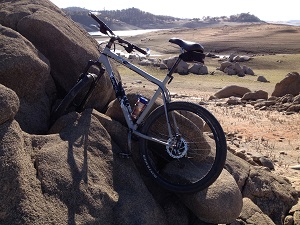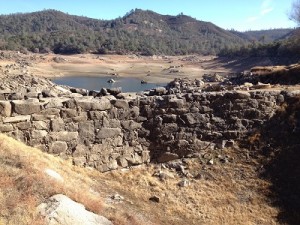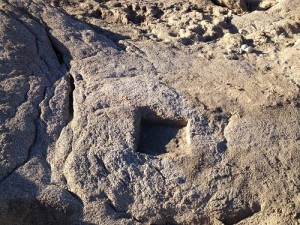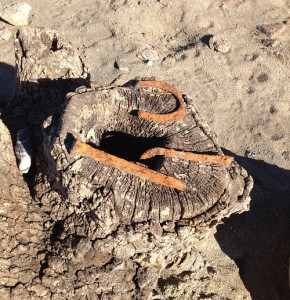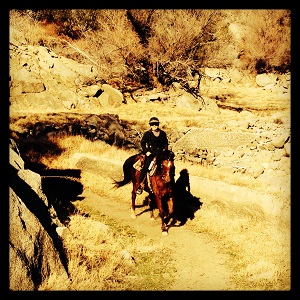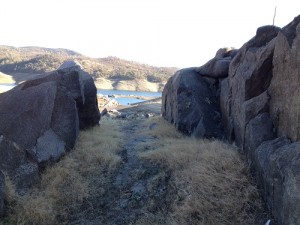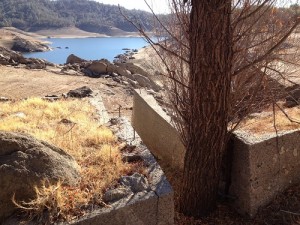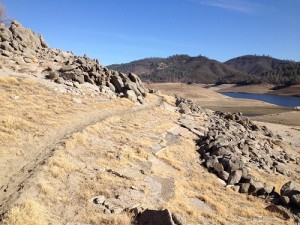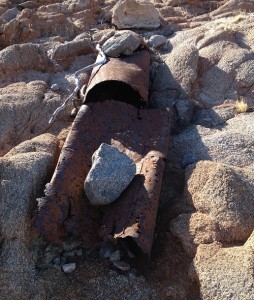The low water levels of Folsom Lake in this drought year of 2014 offer unprecedented opportunities for hiking and biking around usually water-logged historical sites. The fully exposed North Fork Ditch offers a relatively flat trail for mountain biking from Beeks Bight up to Horseshoe Bar. At certain locations, you’ll need to park the bike and hike down to the water’s edge to explore a river and lake bed rarely visible since the 1950’s.
Built by hand on the hillsides
The North Fork Ditch was constructed in the 1850’s to carry water from a dam on the north fork of the American River near Auburn down to Folsom and into present day Orangevale. This water canal, built all by hand, received a concrete lining between 1914 and 1916 to reduce loss from seepage. It is the concrete bottom and sides that remain today and outline the original ditch. See also: North Fork Ditch History
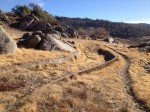
Concrete lining of the NFD pop out of sand and soil when Folsom Lake is low.
NFD had slight slope to convey water
The North Fork Ditch (NFD) became obsolete when the Bureau of Reclamation built Folsom Dam and created the lake. Most of the NFD is below below water when the lake is completely full. But when the lake drops below 410′ elevation or is about 80% full, the NFD becomes visible and accessible from Beeks Bight up to Horseshoe Bar Road. Above Rattlesnake Bar the NFD is permanently above the high water line for Folsom Lake.
Bikes and Horses share the trail
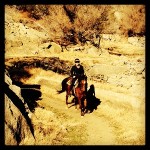
Bikers and horse back riders share the NFD trail.
Because mountain bikes are not allowed on the Pioneer Express Trail north of Beeks Bight, the only opportunity two wheel riders have to explore this part of the lake is when the water is down in the summer and fall. The drought levels of 2014 have brought exceptionally low water levels and a lake that looks miles away from the NFD trail.
Quick sand ahead
The NFD trail was forged by horse riders and can be heavy with sand. The trail weaves in and out of the ditch itself. If the lake bed is dry enough, you can take a short cut across dry lake bottom and have some fun dodging thistles and granite rocks. The worst part of the trail is the sand that either has you peddling 2:1 to move forward or stops you dead in your tracks.
Off trail treks and riding
If the lake is low you can easily get off the trail and ride down to the water’s edge. At some points you have to ditch the bike and
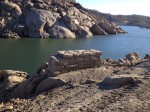
Bridge abutment, American River, 1860’s, low water level of Folsom Lake reveals history.
just hike around the granite outcroppings, cliffs or river cobble rock. The trails and surrounding hills have been smoothed by the rising and falling lake levels over the years. The only real nasty ride is if you traverse dry mud flats of the lake bottom that seem to have deep pock marks every six inches and shake the poop out of you and the bike.
Lots of solitude
It was about a five hour round trip from Beeks Bight up to Horseshoe Bar and back. I probably spent and hour and half hiking around and taking pictures. You can get passed Horseshoe Bar, but you have to navigate around a steep ravine or rocky cliff to get back to a relatively easy riding trail. On my Sunday ride I only encountered four other mountain bikes and about 40 horses. Take lots of water, especially during a summer ride, because there are no services around.
(Click the thumbnails to enlarge pictures)
